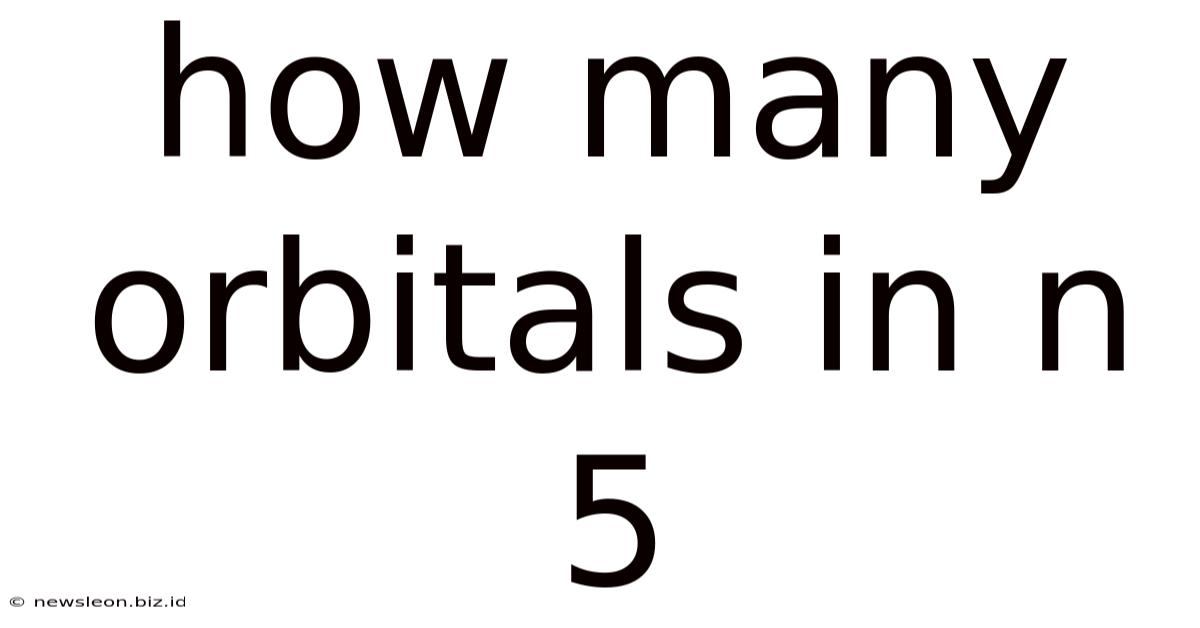How Many Orbitals In N 5
News Leon
Apr 14, 2025 · 5 min read

Table of Contents
How Many Orbitals are in n=5? A Deep Dive into Electron Configuration
Determining the number of orbitals for a given principal quantum number (n) is fundamental to understanding electron configuration and the behavior of atoms. This article delves into the intricacies of calculating the number of orbitals when n=5, exploring the underlying principles and extending the concept to other principal quantum numbers. We’ll also discuss the relationship between orbitals, electron shells, subshells, and the implications for atomic properties.
Understanding Principal Quantum Number (n) and Orbitals
The principal quantum number, n, defines the energy level of an electron in an atom. It's a positive integer (n = 1, 2, 3, ...) and dictates the electron's distance from the nucleus. Higher values of n correspond to higher energy levels and greater distances from the nucleus.
An orbital is a region of space around the nucleus where there's a high probability of finding an electron. Each orbital can hold a maximum of two electrons, according to the Pauli Exclusion Principle. Orbitals are not merely empty spaces; they are defined by specific mathematical functions that describe the electron's wave-like behavior.
Subshells and the Azimuthal Quantum Number (l)
Within each principal energy level (n), there are subshells, denoted by the azimuthal quantum number (l). The value of l can range from 0 to n - 1. Each value of l corresponds to a different type of subshell:
- l = 0: s subshell (spherical shape)
- l = 1: p subshell (dumbbell shape)
- l = 2: d subshell (more complex shapes)
- l = 3: f subshell (even more complex shapes)
- l = 4: g subshell (and so on for higher values of n)
The number of orbitals in a subshell is determined by the magnetic quantum number (m<sub>l</sub>), which can have integer values ranging from -l to +l, including 0. Therefore, each subshell contains (2l + 1) orbitals.
Calculating Orbitals for n=5
For n = 5, the possible values of l are 0, 1, 2, 3, and 4. Let's break down the number of orbitals in each subshell:
- l = 0 (s subshell): (20 + 1) = 1 orbital
- l = 1 (p subshell): (21 + 1) = 3 orbitals
- l = 2 (d subshell): (22 + 1) = 5 orbitals
- l = 3 (f subshell): (23 + 1) = 7 orbitals
- l = 4 (g subshell): (24 + 1) = 9 orbitals
To find the total number of orbitals for n = 5, we simply sum the number of orbitals in each subshell:
1 + 3 + 5 + 7 + 9 = 25 orbitals
Therefore, there are a total of 25 orbitals in the n = 5 principal energy level. Each of these orbitals can hold a maximum of two electrons, meaning the n = 5 shell can accommodate up to 50 electrons.
General Formula for the Number of Orbitals
We can derive a general formula for calculating the total number of orbitals for any given principal quantum number n:
The number of orbitals in a given energy level n is equal to n<sup>2</sup>.
For n = 5, this formula gives us 5<sup>2</sup> = 25 orbitals, which confirms our previous calculation. This formula is incredibly useful for quickly determining the total number of orbitals for any energy level.
Electron Configuration and the Aufbau Principle
The Aufbau principle dictates that electrons fill orbitals in order of increasing energy. While the n = 5 shell can hold 50 electrons, it's rarely completely filled in most atoms. The filling order depends on a combination of n and l, with lower (n + l) values filling before higher ones. This leads to complex electron configurations for larger atoms. For example, the filling order isn't simply 5s, 5p, 5d, 5f, 5g; it intertwines with orbitals from other principal energy levels.
Implications for Atomic Properties
The number of orbitals and the electron configuration significantly influence an atom's properties. The outermost electrons, called valence electrons, are primarily responsible for an atom's chemical reactivity. The n = 5 shell, although rarely fully occupied, plays a role in the chemical behavior of heavier elements. The number of valence electrons, their arrangement in orbitals, and the shielding effect of inner electrons all contribute to an atom's size, ionization energy, electronegativity, and other characteristics.
Extending the Concept to Other Principal Quantum Numbers
The principles discussed here apply to any principal quantum number. Let's briefly illustrate with a few examples:
- n = 1: 1<sup>2</sup> = 1 orbital (1s)
- n = 2: 2<sup>2</sup> = 4 orbitals (2s, 2p<sub>x</sub>, 2p<sub>y</sub>, 2p<sub>z</sub>)
- n = 3: 3<sup>2</sup> = 9 orbitals (3s, 3p<sub>x</sub>, 3p<sub>y</sub>, 3p<sub>z</sub>, 3d<sub>xy</sub>, 3d<sub>xz</sub>, 3d<sub>yz</sub>, 3d<sub>x²−y²</sub>, 3d<sub>z²</sub>)
- n = 4: 4<sup>2</sup> = 16 orbitals (including 4s, 4p, 4d, and 4f orbitals)
Conclusion: A Foundation for Atomic Structure
Understanding the number of orbitals for a given principal quantum number, such as n = 5, is crucial for comprehending atomic structure, electron configuration, and the periodic trends of elements. The simple formula n<sup>2</sup> provides a quick way to calculate the total number of orbitals, while the underlying principles of subshells, quantum numbers, and the Aufbau principle offer a deeper understanding of electron arrangement and atomic properties. This knowledge forms the basis for further explorations in chemistry, physics, and materials science. The detailed examination of the n = 5 shell exemplifies the complexity and elegance of atomic structure. By grasping these fundamental concepts, we can better understand the behavior of matter at the atomic level.
Latest Posts
Related Post
Thank you for visiting our website which covers about How Many Orbitals In N 5 . We hope the information provided has been useful to you. Feel free to contact us if you have any questions or need further assistance. See you next time and don't miss to bookmark.